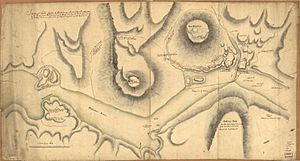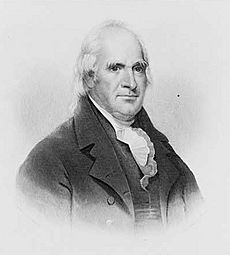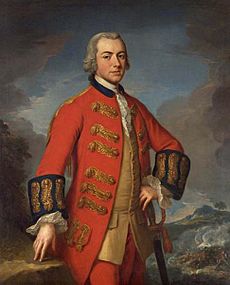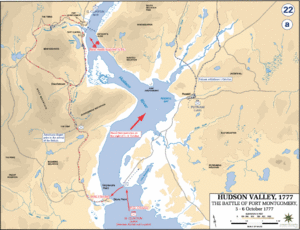Battle of Forts Clinton and Montgomery facts for kids
Quick facts for kids Battle of Forts Clinton and Montgomery |
|||||||
|---|---|---|---|---|---|---|---|
| Part of the American Revolutionary War | |||||||
 A 1777 military map depicting the battle movements |
|||||||
|
|||||||
| Belligerents | |||||||
| Commanders and leaders | |||||||
|
|
|
||||||
| Strength | |||||||
| 600 men | 2,100 men | ||||||
| Casualties and losses | |||||||
| 75 killed and wounded 263 captured |
41 killed 142 wounded |
||||||
Imagine a time when America was fighting for its freedom! The Battle of Forts Clinton and Montgomery was an important fight during the American Revolutionary War. It happened on October 6, 1777, in the Hudson Highlands of New York. British soldiers, led by General Sir Henry Clinton, attacked and captured two American forts: Fort Clinton and Fort Montgomery. They also destroyed a giant chain across the Hudson River that was meant to stop British ships.
The British hoped this attack would distract American soldiers. They wanted to pull American troops away from General Horatio Gates' army, which was fighting another British general, John Burgoyne, further north. Burgoyne was trying to control the Hudson River valley.
About 600 American soldiers defended the forts. They were led by two brothers, General George Clinton (who was also the Governor of New York) and General James Clinton. Another American general, Israel Putnam, was nearby. This battle is sometimes called the "battle of the Clintons" because so many people named Clinton were involved!
Sir Henry Clinton used clever tricks called feints to fool General Putnam. He made it seem like he was attacking in one place, so Putnam moved most of his troops away. Then, Sir Henry landed over 2,000 soldiers on the west side of the Hudson River to attack the forts.
After a tough hike through hills, Clinton's troops attacked both forts at the same time. The battle was quick, and the British won. More than half of the American defenders were killed, hurt, or captured. The British then raided other towns, but their victory came too late to help General Burgoyne, who surrendered his army soon after. The main results were the soldiers lost and the forts being destroyed by the British when they left.
Contents
Why the Hudson River Was Important
The Hudson River valley was a super important area during the American Revolutionary War. It was like a highway for moving supplies, soldiers, and weapons between the New England states and the states further south. Controlling this river was key for both sides.
In June 1777, a British general named John Burgoyne started a plan to take control of this area. He moved his army south from Quebec. At first, he had some success, but his army soon got stuck. By mid-September, he was still far from his goal.
Burgoyne expected help from British forces in New York City. He thought General William Howe would meet him in Albany. But General Howe had other plans!

Howe decided to try and capture Philadelphia instead. He sailed south with most of his army in July. This left Sir Henry Clinton in charge of New York City. Howe told Clinton to mostly defend New York. But he also said Clinton could try to help Burgoyne if he had a good chance.
Burgoyne sent a message to Clinton on September 21. He asked Clinton to attack Fort Montgomery to help his army. Clinton had about 7,000 soldiers in New York, but many were not well-trained.
Preparing for Battle
American Defenses
The Americans had built defenses in the Hudson Highlands near West Point. Major General Israel Putnam was in charge of these troops. His main base was at Peekskill.
A few miles upriver from Peekskill, the Americans had placed a giant chain across the Hudson. This chain was supposed to stop British ships from sailing further north. The western end of the chain was protected by Fort Montgomery. This fort was named after General Richard Montgomery.
South of Fort Montgomery, also on the west side of the river, was Fort Clinton. This fort was probably named after General James Clinton. Fort Montgomery was still being built. General George Clinton was in charge of Fort Montgomery, and his older brother James was in charge of Fort Clinton. Together, they had about 600 soldiers.
General Putnam's main camp at Peekskill had about 600 men. Some of these were regular soldiers, and others were local militia (citizen soldiers). Putnam's forces used to be larger. But General George Washington had ordered some of his troops to help fight General Howe or General Burgoyne.
Putnam learned that British ships were arriving in New York on September 29. He asked Governor Clinton for help. Governor Clinton quickly came south from Kingston to take command of the forts.
British Movements
Sir Henry Clinton received an urgent message from Burgoyne on September 29. Burgoyne directly asked for help. He said an attack on Fort Montgomery would be very useful.
By the end of September, Clinton got 1,700 more soldiers from ships arriving in New York. On October 3, Sir Henry started moving up the Hudson River with 3,000 men. They had three warships and many smaller boats.
The next day, he landed some troops near Tarrytown. This was a feint (a trick) to make Putnam move his troops. These soldiers marched around and then got back on the ships. The ships continued north.
Clinton did another feint at Verplanck's Point on October 5. This was just a few miles south of Peekskill. He easily took over a small American outpost there. These tricks completely fooled Putnam. He pulled his troops back into the eastern hills and sent messages asking for more soldiers.
Just before this, Sir Henry got another message from Burgoyne. Burgoyne asked for clear instructions: should he advance or retreat? He said if he didn't get an answer by October 12, he would have to retreat. Clinton's reply was very formal. He said he was creating a distraction but didn't expect to reach Albany. Luckily for Clinton, none of his messages reached Burgoyne.
The Battle Begins
On the foggy morning of October 6, Sir Henry Clinton landed 2,100 soldiers at Stony Point. This was on the west side of the Hudson River. A Loyalist guide helped them march up a hill called the "Timp."
They came down the other side to a place called Doodletown. There, they met an American scouting party. The scouts had been sent out by Governor Clinton. After a short fight, the scouts ran back toward Fort Clinton.
Sir Henry then split his army into two groups to attack the forts. About 900 men went with Lieutenant Colonel Campbell. They had British soldiers, German chasseurs (light infantry), and about 400 Loyalists. They started a 7-mile hike around a gorge toward Fort Montgomery.
Sir Henry waited with the other 1,200 men at Doodletown. He wanted Campbell's group to have enough time to reach Fort Montgomery. Then, they would attack both forts at the same time.
Governor Clinton quickly sent a message to Putnam asking for help. Soon after, his scouts told him that Sir Henry's forces were divided. While waiting for help (which never came because of Sir Henry's tricks), his brother James sent 100 men from Fort Clinton toward Doodletown. Governor Clinton sent another group from Fort Montgomery to fight Campbell's force.
Fighting at Fort Montgomery
The group from Fort Montgomery had about 100 men. They also had a small cannon led by Captain John Lamb. They set up a defense about a mile from the fort. They fought Campbell's tired soldiers bravely.
They were eventually forced to retreat. But they managed to disable their cannon before leaving it behind. After another stand closer to the fort, they retreated again. Because of their strong defense, Campbell's group didn't reach the fort until about an hour before sunset.

Governor Clinton was offered a chance to surrender, but he refused. The battle then began in full force. Campbell's soldiers attacked the fort. Despite a strong defense and the death of Colonel Campbell, the British broke into the fort. They fought fiercely inside.
James Clinton barely escaped being killed by a bayonet. His orderly book (a small notebook) stopped the weapon's point. He and some of the fort's defenders escaped into the woods north of the fort.
Fighting at Fort Clinton
The main way to get to Fort Clinton was a narrow strip of land. It was about 400 yards wide, between a small lake and the river. The fort's cannons covered this area. Governor Clinton had also put obstacles (called abatis) to slow down the British.
Sir Henry sent some soldiers around the lake to attack Fort Clinton from the northwest. At the same time, he sent other groups to attack the main defenses. As at Fort Montgomery, the defenders were eventually overwhelmed.
However, the soldiers who surrendered at Fort Clinton were treated better. Many of the American soldiers, including General Clinton, escaped. They climbed down the riverbank, and gunboats took them safely across the river.
After the Battle
Soldiers Lost
The British lost 41 soldiers killed and 142 wounded. The Americans lost about 75 killed and wounded. They also had 26 officers and 237 enlisted men captured. The Americans also had to destroy several boats because the wind kept them from sailing away.
The next day, Sir Henry sent a small group to Fort Constitution. This was a small outpost across from West Point. He demanded that they surrender. The few soldiers there refused at first. But they left the fort on October 8 when a larger British force arrived.
Governor Clinton and General Putnam made new plans. Clinton decided to move north with troops on the western side of the river. This was to defend against attacks further upriver. Putnam would defend against attacks to the east.
More British Actions
Captain James Wallace started clearing the river of American obstacles after the battle. By October 13, he reported that the river was clear. Sir Henry had returned to New York because he was sick. He left General John Vaughan in charge of the forts.
Vaughan and 1,700 men sailed up the Hudson River on October 15. Their orders were to find General Burgoyne and help him. They stopped near Esopus that evening. Some people think this movement affected Burgoyne's surrender talks. But it's unlikely General Gates knew about it until after the surrender on October 17.
Vaughan's troops burned Esopus the next day. Then they sailed further north and raided the Livingston Manor, a famous Patriot family's home. Putnam's forces, which had grown with new militia, chased the British fleet. Putnam's army was a big enough threat that Vaughan pulled his troops back to the boats.
On October 17, Sir Henry received a request for 3,000 men from General Howe. Howe needed help to occupy Philadelphia. Since the New York army was already small, Clinton called Vaughan and the soldiers holding the two forts back. The forts were destroyed, and the troops left on October 26.
What Remains Today
The site of Fort Clinton was mostly torn down. This was to build U.S. Route 9W and the Bear Mountain Bridge, which opened in 1924. What's left of Fort Clinton is now part of Bear Mountain State Park. This park also includes the old, empty town of Doodletown.
Fort Montgomery is now part of the Fort Montgomery State Historic Site. It was named a National Historic Landmark in 1972. It was also added to the National Register of Historic Places that year.
Images for kids






